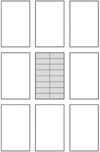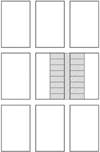Identifying Streetscape Features Significant to Well-Being
- PMID: 23144498
- PMCID: PMC3491910
- DOI: 10.3763/asre.2007.5029
Identifying Streetscape Features Significant to Well-Being
Abstract
To determine effective relationships between the built environment and health and well-being, a transdisciplinary team of architectural, behavioral and health scientists developed a built environment coding system (UMBECS). They examined the relationship of resulting streetscape features to health and well-being at the block level. The research team conducted studies of the validity of UMBECS focusing on children through school conduct and grades, and on elders through a longitudinal cognitive functioning study. For children, contrary to popularly held views, commercial-residential mix was as effective as a high proportion of residential use in predicting children's school outcomes (i.e., better conduct, achievement, effort, and grades). For elders, modest but statistically significant relationships existed between block-level features, elders' neighboring behaviors, and social support, which in turn were significantly associated with cognitive and affective functioning. These findings suggest the utility of this built environment coding system for examining the relationship of built environment features to residents' health and well-being. UMBECS offers a useful tool for developing a viable transdisciplinary model of the role of the built environment in behavioral and health outcomes.
Figures








Similar articles
-
Built environment and physical functioning in Hispanic elders: the role of "eyes on the street".Environ Health Perspect. 2008 Oct;116(10):1300-7. doi: 10.1289/ehp.11160. Epub 2008 May 28. Environ Health Perspect. 2008. PMID: 18941569 Free PMC article.
-
The relationship of built environment to perceived social support and psychological distress in Hispanic elders: the role of "eyes on the street".J Gerontol B Psychol Sci Soc Sci. 2009 Mar;64(2):234-46. doi: 10.1093/geronb/gbn011. Epub 2009 Feb 4. J Gerontol B Psychol Sci Soc Sci. 2009. PMID: 19196696 Free PMC article.
-
The impact of the built environment on children's school conduct grades: the role of diversity of use in a Hispanic neighborhood.Am J Community Psychol. 2006 Dec;38(3-4):299-310. doi: 10.1007/s10464-006-9084-x. Am J Community Psychol. 2006. PMID: 16967342 Free PMC article.
-
How the Built Environment Shapes Children's Microbiome: A Systematic Review.Microorganisms. 2025 Apr 20;13(4):950. doi: 10.3390/microorganisms13040950. Microorganisms. 2025. PMID: 40284786 Free PMC article. Review.
-
Associations of built environment and children's physical activity: a narrative review.Rev Environ Health. 2017 Dec 20;32(4):315-331. doi: 10.1515/reveh-2016-0046. Rev Environ Health. 2017. PMID: 28809754 Review.
Cited by
-
Good places for ageing in place: development of objective built environment measures for investigating links with older people's wellbeing.BMC Public Health. 2011 Nov 1;11:839. doi: 10.1186/1471-2458-11-839. BMC Public Health. 2011. PMID: 22044518 Free PMC article.
-
Built environment and physical functioning in Hispanic elders: the role of "eyes on the street".Environ Health Perspect. 2008 Oct;116(10):1300-7. doi: 10.1289/ehp.11160. Epub 2008 May 28. Environ Health Perspect. 2008. PMID: 18941569 Free PMC article.
-
The relationship of built environment to perceived social support and psychological distress in Hispanic elders: the role of "eyes on the street".J Gerontol B Psychol Sci Soc Sci. 2009 Mar;64(2):234-46. doi: 10.1093/geronb/gbn011. Epub 2009 Feb 4. J Gerontol B Psychol Sci Soc Sci. 2009. PMID: 19196696 Free PMC article.
-
Clinical practice guidelines on the environment and mental well-being.Indian J Psychiatry. 2024 Jan;66(Suppl 2):S372-S390. doi: 10.4103/indianjpsychiatry.indianjpsychiatry_792_23. Epub 2024 Jan 24. Indian J Psychiatry. 2024. PMID: 38445269 Free PMC article. No abstract available.
-
The relationship of perceived neighborhood social climate to walking in Hispanic older adults: a longitudinal, cross-lagged panel analysis.J Aging Health. 2011 Dec;23(8):1325-51. doi: 10.1177/0898264311418502. Epub 2011 Sep 1. J Aging Health. 2011. PMID: 21885705 Free PMC article.
References
-
- Abu-Ghazzeh TM. Housing layout, social interaction, and the place of contact in Abu-Nusier, Jordan. Journal of Environmental Psychology. 1999;19:41–73.
-
- Adler N, Matthews K. Health psychology: Why do some people get sick and some stay well? Annual Review of Psychology. 1994;45:229–259. - PubMed
-
- Anastasi A. Emerging concepts of test validation. Annual Review of Psychology. 1986;37:1–15.
-
- Barker RG. Ecological psychology. Stanford, CA: Stanford University Press; 1968.
-
- Bronfenbrenner U. Contexts of child rearing: Problems and prospects. American Psychologist. 1979;34(10):844–850.
Grants and funding
LinkOut - more resources
Full Text Sources
